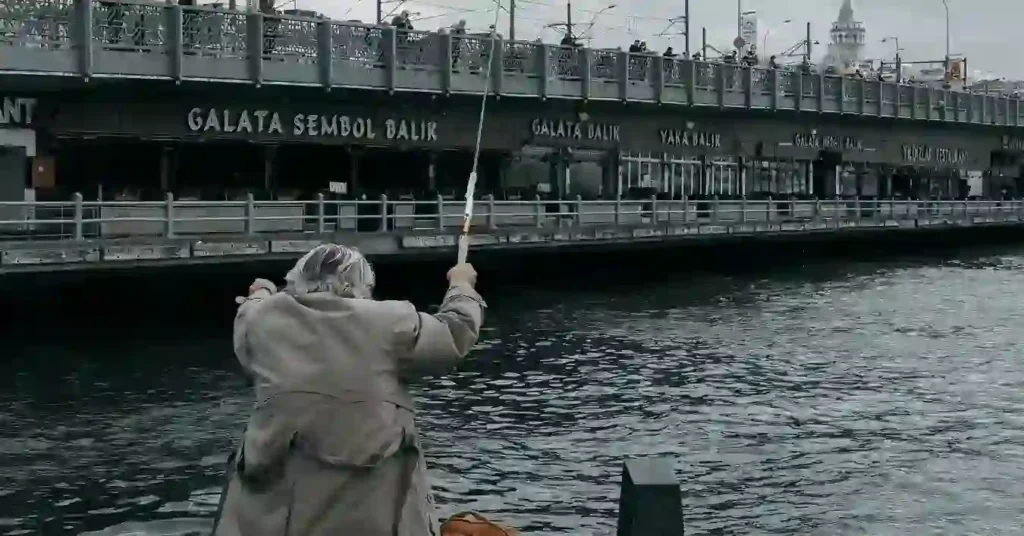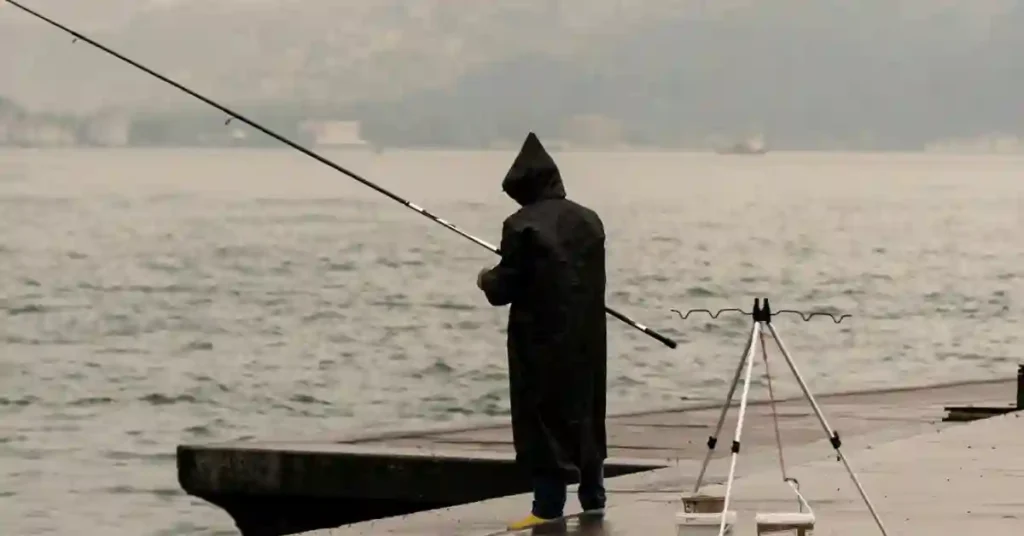What Is Urban Fly Fishing? Best Guide, Tactics, & Places
Many people in cities find it challenging to access the outdoors, wilderness, or nature quickly and easily. Even if you can reach those “better” rivers and lakes, how often can you go, maybe just a weekend here or there? However, in our cities, blue places on the maps are nearby, offering a chance to catch various fish species. Urban fly fishing provides a new way to explore your city. It can be one of the most affordable ways to enjoy fly fishing regularly.
In this Guide, we will discuss urban fly fishing, its advantages, and places you can go fishing.
What is Urban Fly Fishing?
When people think about fly fishing, they often picture scenes in the countryside with mountains or catching fish in sunny Florida. We usually imagine going to beautiful, untouched places for fishing. But have you ever thought about fly fishing just a few blocks away from a pawn shop or under a bridge?

Think of a fly rod as a linear spring. A suitably weighted line will cause the rod’s tip to bend as you start casting, known as loading. As you extend the line, the rod accumulates more energy and transfers it to the line when you stop the rod on your final forward cast. Even though fly fishing is usually linked with going into the wild and enjoying the untouched beauty
of nature, urban fly fishing is a new way to do fly fishing. Let’s learn more about urban fly fishing, what it is, how it works, and what makes it different from other types of fly fishing. With urban fly fishing, your next great fishing spot might be nearby. However, like riding a bike or shooting a basketball, casting a fly rod is easier done than described. Orvis offers beginner fly fishing classes at various locations in the United States for fly fishing, which are highly recommended for first-timers.
Urban Fly Fishing Unveiled
Urban fly fishing is about doing fly fishing in cities or towns instead of in the countryside. Instead of going far into the wilderness, people who do urban fly fishing look for fish in the middle of the city. Imagine casting your fishing line near everyday things like pawn shops or under bridges.
How It Works
The basic idea of fly fishing is still the same in the city. Urban anglers use a special rod, reel, and line to catch fish with artificial flies. The main difference is the background – instead of being surrounded by nature, you’re in a city with buildings, roads, and other things. People might fish in rivers in the city, ponds in parks, or even drainage canals, finding exciting fishing spots close to home.
What Makes It Special
Urban fly fishing is different because of where you fish. Instead of going to clean and natural places, anglers face the challenges and enjoy the rewards of fishing in city waters. Being close to city life adds extra excitement and makes the experience unique. Urban fly fishing lets people find hidden bits of nature in the city, giving a new way to enjoy this classic sport.
Why Urban Fishing is Exciting?
For many of us, a day of fishing usually involves waiting for the weekend and spending a lot of time in the car. However, urban fishing adds a new dimension of fun. Achieving that meditative tranquillity induced by fishing doesn’t require much when you cast your rod closer to home.
Urban fly fishing used to be somewhat overlooked. Still, more and more people are discovering the joy of finding fish in their neighbourhoods. The adventure associated with urban fishing is one of its best parts. Many cities have numerous bodies of water filled with fish, and part of the challenge is uncovering these hidden gems. Moreover, urban fishing spots often have less fishing pressure, making it an exciting endeavour for committed anglers like yourself, willing to walk past picnickers, Sunday joggers, and bustling construction sites with a rigged fly rod.
One of the significant advantages of urban angling is the opportunity to witness improvement in your fishing skills. By targeting different fish species in diverse bodies of water, you’ll enhance your casting techniques, fly selection, and presentation. Pursuing challenges such as creeping up on cruising carp will improve your skills and increase your success in catching trout on those clear-water days. Lastly, urban fly fishing is easy to learn.
Basics of Urban Fly Fishing
Urban fly fishing involves using a fly fishing setup to catch different fish species in a city environment. This environment could be a river flowing through downtown, a lake near a new development, or any unexpected body of water where fly fishing is not typically imagined.
The good news is that fishing in urban areas is similar to rural ones. You don’t need to worry about buying a new rod and reel setup. Identify the types of fish found near you, set up your gear accordingly, and enjoy catching a big fish right in the city’s heart.
Urban Fly Fishing Tactics
When it comes to urban fly fishing, having quantities of flies is often more important than quality. Urban environments can be filled with woody debris, concrete, and various obstacles hidden underwater, leading to the frequent loss of flies. Consider your urban flies as expendable, and opt for cost-effective options, whether purchasing them or tying them yourself. This approach, though it may sacrifice the intricacy of fly patterns, significantly reduces the learning curve for urban fishing.
In areas with dirty, muddy, or off-color water, opt for high-contrasting fly patterns that incorporate flash and, perhaps, rattles. Urban waters can often be murky, making it challenging for fish to discern fly presentations. Choose colors that contrast with the water and incorporate flashy elements. While the effectiveness of rattles is debated, they are worth trying, especially for predatory fish like smallmouth, largemouth, and pike.
Experiment with a variety of nymphing techniques to adapt to different fishing conditions. When facing challenges, mix things up by employing tightline techniques, using an indicator, or trying a dry-dropper setup. A popper-dropper approach can also be effective, where a foam or deer hair popper suspends a weighted nymph beneath. There are no strict rules for this setup, so experiment with twitching, popping, and letting the popper sit still. If the popper doesn’t attract attention, the nymph often becomes the target. Additionally, try swinging nymphs through the current and slowly retrieving them, especially in ponds.
Explore diverse urban fishing areas such as below dams (including low-head dams), bridges, riprap, and even outflows from wastewater treatment plants. Fish tend to gather in significant numbers beneath treatment outflows, especially in winter. Despite initial reservations, the water from treatment plants is treated, and these locations can attract large fish. Riprap, consisting of concrete blocks or rocks piled along the bank, serves as excellent habitat for crayfish, baitfish, and aquatic insects. Predatory fish like smallmouth and largemouth bass are drawn to these areas for hunting and ambushing prey. When you encounter riprap, take your time and fish it thoroughly for the best results.
Best Cities For Urban Fly Fishing
Almost every major city offers some urban fly fishing appeal, but here’s our perspective on the top 10 cities worldwide where you can catch fish right in the heart of town.
The following are the best places for fly fishing in USA:
Minneapolis, Minnesota
Minneapolis, Minnesota, known as the “Land of 10,000 Lakes,” provides excellent opportunities for fly fishing right within the city limits. Minneapolis is home to several lakes, some of which are situated in the heart of the city. Finding an urban fishing spot is easy, with parks featuring stocked ponds and creeks scattered throughout. Key destinations in the Twin Cities include St. Anthony Main near the Stone Arch Bridge, Lake Calhoun, and Como Lake in St. Paul. When fishing in urban Minneapolis waters, aim for panfish such as bluegill and crappie for a rewarding experience.
Boise, Idaho
Boise, Idaho, is a fantastic spot for fly-fishing, offering a unique experience right in the heart of downtown. Similar to Denver, Boise allows anglers to reel in impressive fish without venturing far from the city center. The Boise River is a prime destination, renowned as one of the top urban fly fishing spots in the country. Anglers can target brown trout and various other types of trout, making it an excellent location for fly fishing enthusiasts.
Austin, Texas
Austin, Texas is a perfect place for people who love fishing in urban areas. It has various water bodies like streams, creeks, rivers, lakes, and ponds that make it a haven for anglers. The Colorado River flows through the town, and there are many other smaller streams and tributaries around. You can find largemouth and Guadalupe bass easily, and the lakes and ponds in the city also have catfish, panfish, and carp, as well as alligator gar.
New York City, New York
In New York City, New York, urban fishing opportunities are abundant. Whether you’re into catching brook trout on Long Island or stripers in the lower Hudson River, there’s something for everyone. The city is dotted with ponds and lakes stocked with bass and panfish. If you prefer saltwater fishing, head to Jamaica Bay for fluke and bluefish.
Denver, Colorado
Denver, Colorado, besides being the gateway to the Rockies, offers excellent urban fishing. The South Platte River runs through downtown, providing anglers with opportunities to catch carp, smallmouth and largemouth bass, bluegill, suckers, catfish, and walleye, with the occasional rainbow trout. It’s a diverse fishing experience right in the heart of the city.
Sacramento, California
Sacramento, California, known as “River City,” is a great destination for urban fly fishing. The Sacramento and American rivers, meeting in the downtown area, offer fantastic opportunities. The lower Sacramento River is famous for salmon, striped and largemouth bass, and shad. The American River hosts memorable steelhead and king salmon runs and is easily accessible via the American River Parkway.
Miami, Florida
In Miami, Florida, anglers can enjoy a variety of fishing experiences. From wading into flats for tarpon, bonefish, and permit to freshwater canals for peacock bass, Miami has it all. The city’s incredible year-round weather makes it a perfect destination for fishing enthusiasts.
The Twin Cities, Minnesota
The Twin Cities, Minneapolis and St. Paul in Minnesota, provide excellent urban fishing opportunities. Known as the “City of Lakes,” Minneapolis has numerous lakes within the city limits, and the Mississippi River divides the two cities, offering a chance to catch bass, crappie, musky, walleye, and pike.
Dubai, United Arab Emirates
Dubai, United Arab Emirates, known for its towering buildings, is becoming a hot spot for urban fly fishing. Surrounded by impressive architecture, anglers can access sought-after fish like queenfish, golden trevally, kingfish, cobia, and bonito.
Melbourne/Sydney, Australia
Melbourne and Sydney in Australia offer fantastic urban fishing opportunities. Melbourne, in particular, stands out with hungry trout and salt-water classics. Anglers can start their adventure on the Yarra River or explore local lakes for still-water fun. Sydney Harbour provides an opportunity for saltwater fishing.
London, England
Even London, England, known for its hustle and bustle, has urban fishing opportunities. With numerous streams and canals flowing into the famous River Thames, anglers can catch a variety of fish, including carp, brown trout, and even sea trout and salmon making runs into town.
Best Places to Go Fishing in Your City
The following are the some of the best place to fly fish:
Urban Rivers, Streams, and Creeks
I always keep Google Maps open on my computer. During the day, I look at the map and find potential fishing spots. If you want to fish in rivers and plan to walk in the water (Wade), focus on smaller rivers, around 100 feet across or less. Check for smaller rivers like streams and creeks if a river seems too broad. Once you find a spot, switch to satellite view. There are many river in USA to Fish.

First, make sure the river is there and not dry. Check if the banks are full of plants – it might be hard to fish from the bank if they are. Look for riffles (ripples in the water) – it could mean the water is shallow and suitable for walking. Also, look for gravel bars and sandy/rocky banks, as these make casting easier. Check if the river banks are not marshy, as that makes fishing on foot difficult. Lastly, look for islands, gravel bars, narrow spots, and bends in the river – these are good places to find fish.
To double-check your map scouting, find a bridge or nearby road for street view. The street view might show someone fishing, making you more confident in the location. Ensure you can quickly get to the river or stream by looking for parks, walking paths, or bridges. I like walking paths because I can fish and walk back without wading more. Remember that rain affects urban rivers and streams a lot. Use the USGS National Water Dashboard to check the river’s current levels.
Urban Ponds, Lakes, and Saltwater
Lakes and ponds are good places to fish for panfish, carp, and largemouth bass. Look for ponds in parks with open areas for casting. Irregularly shaped ponds with inlets and shallow areas are good. Check the satellite view for overgrown features like lily pads or algae, especially in summer.
When fishing in lakes and saltwater, look for harbours, piers, shorelines, beaches, canals, and jetties on the map. Finding places the public can go can be challenging, so use street view and explore on foot if needed. Public areas can get crowded, so consider going earlier or later in the day or exploring less-known spots. If your city is near lakes or the coast, contemplate acquiring a kayak or paddleboard to explore these waters.
Using Resources: Fly and Tackle Shops, Fishing Clubs, Forums, and More
Besides looking at the map, check other helpful resources. Local fly or tackle shops have good information and might offer trips. Fishing clubs and communities are places to meet other anglers and learn about local fishing. Look online for forums or Reddit to find information or ask questions about your local fishing spots. Search the internet for articles about fishing in your city. Call city park staff for recommendations and check their websites for more information on fishing opportunities.
Final Words
As we wrap up our exploration of Urban Fly Fishing, remember to embrace the unique blend of city life and nature in this thrilling angling experience. Whether you’re a seasoned urban angler or a curious beginner, take these insights with you as you explore waterways amidst skyscrapers and city parks.
Urban Fly Fishing is more than a sport; it’s a connection to nature in the midst of the hustle and bustle. So, tighten those lines, cast with flair, and turn your urban fishing outings into unforgettable stories.

Meet Ibrahim Khan, an avid angler and author in Fishing Teach. He shares his wealth of knowledge from his 16 years of experiences in fishing. His articles are a captivating blend of practical insights and thrilling tales that invite readers into the enchanting world of fishing.
Ibrahim’s guides are your go-to guide in the realm of fishing on this informational site. Hailing from a coastal paradise, Ibrahim’s passion for angling is the heartbeat of his life.
